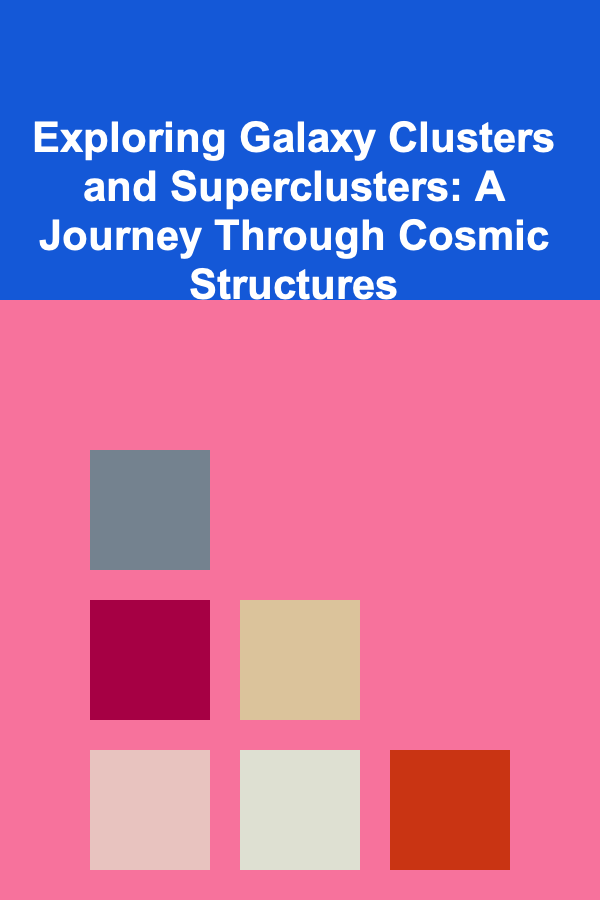
Exploring Galaxy Clusters and Superclusters: A Journey Through Cosmic Structures
ebook include PDF & Audio bundle (Micro Guide)
$12.99$8.99
Limited Time Offer! Order within the next:

The universe, at its largest scales, is not a uniform sea of galaxies. Instead, galaxies congregate in vast, complex structures known as galaxy clusters and superclusters, linked together by filaments of dark matter and gas. Understanding these cosmic structures is crucial for unraveling the mysteries of dark matter, dark energy, galaxy evolution, and the large-scale structure of the cosmos. This exploration delves into the methods and techniques used to discover, characterize, and study these magnificent objects, offering a glimpse into the ongoing quest to map the universe.
I. What are Galaxy Clusters and Superclusters?
Before diving into the exploration methods, it's essential to define what exactly we're trying to find.
A. Galaxy Clusters: Gravitational Havens
Galaxy clusters are the largest gravitationally bound structures in the universe. They typically contain hundreds to thousands of galaxies, all orbiting within a shared halo of dark matter. This dark matter halo, which accounts for the vast majority of the cluster's mass, provides the gravitational scaffolding that holds the galaxies together. The space between the galaxies is filled with a hot, diffuse plasma known as the intracluster medium (ICM), which emits X-rays. This ICM is heated to temperatures of millions of degrees Kelvin due to the enormous gravitational forces within the cluster.
Key characteristics of galaxy clusters include:
- High galaxy density: Significantly higher than the average density of galaxies in the universe.
- Dark matter dominance: Dark matter constitutes the majority of the cluster's mass.
- Intracluster medium (ICM): Hot, X-ray emitting plasma filling the space between galaxies.
- Gravitational lensing: The cluster's mass bends the light from background galaxies, distorting their shapes.
B. Superclusters: The Cosmic Web
Superclusters are even larger structures, composed of multiple galaxy clusters and groups of galaxies, linked together by filaments of galaxies and dark matter. They represent the highest densities in the cosmic web, a vast network of interconnected filaments, sheets, and voids that permeate the universe. Superclusters are not necessarily gravitationally bound, and their constituent clusters are still moving away from each other due to the expansion of the universe, albeit at a slower rate than regions outside the supercluster.
Key characteristics of superclusters include:
- Largest known structures: Spanning hundreds of millions of light-years.
- Collection of clusters: Containing multiple galaxy clusters and groups.
- Filamentary structure: Composed of interconnected filaments of galaxies.
- Complex dynamics: Not necessarily gravitationally bound, influenced by the expansion of the universe.
II. Techniques for Finding Galaxy Clusters and Superclusters
Identifying these cosmic structures requires a combination of observational techniques, leveraging different parts of the electromagnetic spectrum and employing sophisticated data analysis methods.
A. Optical Surveys: Mapping the Distribution of Galaxies
Optical surveys are a fundamental tool for identifying galaxy clusters and superclusters. By systematically mapping the distribution of galaxies across the sky, astronomers can identify regions with significantly higher galaxy densities, which are indicative of clusters and superclusters.
1. Redshift Surveys: Redshift surveys measure the redshifts of galaxies, which provides information about their distances. This allows astronomers to create 3D maps of the galaxy distribution and identify clusters and superclusters as overdensities in space. Large redshift surveys, such as the Sloan Digital Sky Survey (SDSS) and the 2dF Galaxy Redshift Survey, have been instrumental in mapping the large-scale structure of the universe.
2. Photometric Redshift Surveys: Obtaining spectroscopic redshifts for a large number of galaxies can be time-consuming. Photometric redshifts offer a faster alternative. By measuring the brightness of galaxies in different color filters, astronomers can estimate their redshifts based on the spectral energy distribution of galaxies. While less precise than spectroscopic redshifts, photometric redshifts are sufficient for identifying large-scale structures like clusters and superclusters over vast areas of the sky. Examples include the Dark Energy Survey (DES) and the Hyper Suprime-Cam Subaru Strategic Program (HSC-SSP).
3. Friends-of-Friends (FoF) Algorithm: This algorithm is commonly used to identify clusters and superclusters in redshift surveys. It links galaxies together based on their proximity in space, forming groups of galaxies that are considered to be part of the same structure. The linking length parameter in the FoF algorithm determines how close galaxies need to be to be considered connected.
B. X-ray Observations: Unveiling the Hot Gas
X-ray observations provide a powerful complementary method for identifying galaxy clusters. The hot intracluster medium (ICM) emits X-rays, making clusters readily detectable in X-ray surveys. X-ray observations are particularly useful for identifying clusters that are faint or difficult to detect in optical surveys.
1. X-ray Telescopes: Space-based X-ray telescopes, such as Chandra X-ray Observatory and XMM-Newton, are essential for detecting and studying the ICM. These telescopes provide high-resolution images and spectra of the X-ray emission, allowing astronomers to measure the temperature, density, and composition of the ICM.
2. Identifying Clusters from X-ray Emission: Galaxy clusters appear as extended sources of X-ray emission in X-ray images. The X-ray luminosity of a cluster is related to its mass, making X-ray observations a valuable tool for estimating cluster masses. The morphology of the X-ray emission can also provide clues about the dynamical state of the cluster. For example, clusters undergoing mergers often exhibit irregular X-ray morphologies.
C. Sunyaev-Zel'dovich (SZ) Effect: Distorting the Cosmic Microwave Background
The Sunyaev-Zel'dovich (SZ) effect is a powerful method for detecting galaxy clusters at millimeter wavelengths. The SZ effect is the distortion of the cosmic microwave background (CMB) radiation by the hot electrons in the ICM. As CMB photons pass through the ICM, they are scattered by the hot electrons, resulting in a change in the CMB's spectrum. This change is detectable as a decrement in the CMB's intensity at lower frequencies and an increment at higher frequencies.
1. SZ Surveys: SZ surveys, such as those conducted by the Atacama Cosmology Telescope (ACT) and the South Pole Telescope (SPT), are designed to detect galaxy clusters via the SZ effect. These surveys are particularly effective at finding clusters at high redshifts, where optical and X-ray observations become more challenging.
2. SZ Effect and Cluster Mass: The strength of the SZ effect is directly related to the integrated pressure of the ICM, which is a proxy for the cluster's mass. This makes the SZ effect a valuable tool for estimating cluster masses, independent of redshift.
D. Gravitational Lensing: Bending the Fabric of Spacetime
Gravitational lensing occurs when the mass of a foreground object, such as a galaxy cluster, bends the light from background galaxies, distorting their shapes. This effect can be used to map the distribution of dark matter in the cluster and to estimate the cluster's mass. There are two main types of gravitational lensing:
1. Strong Lensing: Strong lensing occurs when the alignment between the foreground lens and the background source is nearly perfect, resulting in highly distorted images of the background source, such as arcs or Einstein rings. Strong lensing is relatively rare but provides precise measurements of the cluster's mass distribution in the central regions.
2. Weak Lensing: Weak lensing is a more common phenomenon that causes subtle distortions in the shapes of background galaxies. By statistically analyzing the shapes of a large number of background galaxies, astronomers can map the distribution of dark matter in the cluster and estimate its total mass. Weak lensing provides a valuable tool for probing the outer regions of clusters, where the effects of strong lensing are negligible.
3. Lensing Surveys: Dedicated lensing surveys, such as the Dark Energy Survey (DES) and the Hyper Suprime-Cam Subaru Strategic Program (HSC-SSP), are designed to measure the shapes of a large number of galaxies over wide areas of the sky, enabling the mapping of dark matter distributions in galaxy clusters and superclusters.
E. Combining Multiple Methods: A Multi-Wavelength Approach
The most effective way to explore galaxy clusters and superclusters is to combine multiple observational techniques. By combining optical, X-ray, SZ, and lensing data, astronomers can obtain a more complete and accurate picture of these complex structures. For example, optical surveys can be used to identify candidate clusters, which can then be confirmed and characterized with X-ray observations. SZ observations can provide independent mass estimates, while gravitational lensing can map the distribution of dark matter. This multi-wavelength approach allows astronomers to overcome the limitations of any single technique and to gain a deeper understanding of the physics of galaxy clusters and superclusters.
III. Challenges in Exploring Galaxy Clusters and Superclusters
Despite the powerful techniques available, exploring galaxy clusters and superclusters presents several challenges.
A. Projection Effects: Overlapping Structures
When observing the universe, we are limited to viewing structures along our line of sight. This can lead to projection effects, where unrelated structures appear to be connected along the same line of sight. Distinguishing between true clusters and superclusters and chance alignments requires careful analysis of the 3D distribution of galaxies, which can be challenging, especially at large distances.
B. Contamination from Foreground and Background Galaxies
When identifying galaxy clusters and superclusters based on galaxy density, it is essential to account for contamination from foreground and background galaxies that are not physically associated with the structure. These contaminating galaxies can artificially inflate the apparent density of the cluster or supercluster, leading to inaccurate measurements of its properties. Redshift information is crucial for removing these contaminants, but obtaining redshifts for a large number of galaxies can be time-consuming.
C. Modeling the Intracluster Medium (ICM)
Accurately modeling the ICM is essential for interpreting X-ray and SZ observations of galaxy clusters. The ICM is a complex plasma that is influenced by a variety of physical processes, including heating, cooling, mergers, and feedback from active galactic nuclei (AGN). Developing accurate models of these processes is challenging, and uncertainties in the ICM modeling can lead to systematic errors in the derived cluster properties, such as mass and temperature.
D. Understanding the Role of Dark Matter
Dark matter plays a crucial role in the formation and evolution of galaxy clusters and superclusters. However, the nature of dark matter remains a mystery. Understanding the properties of dark matter is essential for accurately modeling the formation of these structures and for interpreting observations of their mass distributions. Observations of gravitational lensing and the dynamics of galaxies within clusters provide valuable constraints on the properties of dark matter.
E. Distinguishing Real Superclusters from Filaments
Defining the boundaries of superclusters and distinguishing them from the surrounding filaments is a challenging task. Superclusters are often connected to filaments of galaxies, and it can be difficult to determine where the supercluster ends and the filament begins. Different definitions of superclusters can lead to different catalogs of these structures, making it difficult to compare results from different studies. More sophisticated methods for identifying and characterizing superclusters are needed to address this issue.
IV. Future Directions in Exploring Galaxy Clusters and Superclusters
The exploration of galaxy clusters and superclusters is an ongoing endeavor, driven by advancements in observational technology and theoretical understanding. Future missions and research directions promise to further revolutionize our understanding of these cosmic structures.
A. Next-Generation Surveys
Next-generation surveys, such as the Vera C. Rubin Observatory's Legacy Survey of Space and Time (LSST) and the Euclid mission, will provide unprecedented data on the distribution of galaxies and the properties of galaxy clusters and superclusters. LSST will map the sky repeatedly over a period of ten years, providing deep, high-resolution images that will enable the detection of faint galaxies and the precise measurement of galaxy shapes for weak lensing studies. Euclid will map the large-scale structure of the universe using both weak lensing and galaxy clustering, providing a powerful probe of dark energy and the nature of gravity.
B. Improved Modeling of the ICM
Improving our understanding of the ICM is crucial for accurately interpreting X-ray and SZ observations of galaxy clusters. Future research will focus on developing more sophisticated models of the ICM that incorporate the effects of heating, cooling, mergers, and AGN feedback. These models will be tested against observations from current and future X-ray and millimeter-wave telescopes.
C. Connecting Observations to Simulations
Cosmological simulations play a crucial role in understanding the formation and evolution of galaxy clusters and superclusters. Future research will focus on connecting observations of these structures to the predictions of cosmological simulations. This will involve comparing the observed properties of clusters and superclusters to the properties of simulated structures, and using these comparisons to refine our understanding of the underlying physics.
D. Exploring the Role of Environment on Galaxy Evolution
Galaxy clusters and superclusters provide a unique environment for studying the effects of environment on galaxy evolution. Galaxies in dense environments experience a variety of physical processes, such as ram pressure stripping and tidal interactions, that can affect their star formation and morphology. Future research will focus on exploring the role of these processes in shaping the properties of galaxies in clusters and superclusters.
E. Unveiling the Connection to the Cosmic Web
Understanding the connection between galaxy clusters and superclusters and the larger cosmic web is a key goal of modern cosmology. Future research will focus on mapping the distribution of galaxies and dark matter in the vicinity of clusters and superclusters, and on studying the dynamics of the gas and galaxies in these regions. This will provide insights into the formation and evolution of the cosmic web and its influence on the formation of galaxies and clusters.
V. Conclusion: A Universe of Structure and Mystery
Exploring galaxy clusters and superclusters is a fundamental endeavor in modern astrophysics. These vast cosmic structures offer a unique window into the nature of dark matter, dark energy, galaxy evolution, and the large-scale structure of the universe. By combining multiple observational techniques with sophisticated data analysis and theoretical modeling, astronomers are making significant progress in unraveling the mysteries of these magnificent objects. The future holds great promise for further advancements in our understanding of galaxy clusters and superclusters, driven by next-generation surveys, improved modeling of the ICM, and a deeper connection between observations and simulations. As we continue to explore these cosmic structures, we will undoubtedly gain new insights into the fundamental laws that govern the universe.

How to Create a Recipe Book Collaboratively with Family and Friends
Read More
How to Create Ambiance with Lighting in Your Bedroom
Read More
How to Manage Student Loans Effectively and Pay Them Off
Read More
How to Regulate Blockchain Technology Effectively
Read More
How to Deal with Sleep Problems in Older Children
Read More
Discovering the Twelve Labors of Hercules: A Journey of Myth and Meaning
Read MoreOther Products

How to Create a Recipe Book Collaboratively with Family and Friends
Read More
How to Create Ambiance with Lighting in Your Bedroom
Read More
How to Manage Student Loans Effectively and Pay Them Off
Read More
How to Regulate Blockchain Technology Effectively
Read More
How to Deal with Sleep Problems in Older Children
Read More